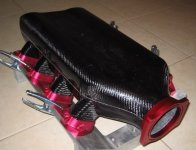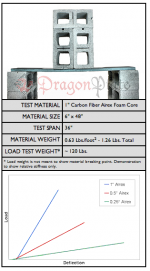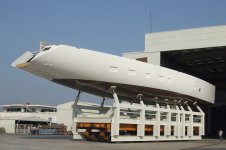You know, now that you mentioned, I have been exploring the possibility of using carbon fibre for various purposes.
AR2--you're exactly right! Besides the obvious esthetic appeal of twill-weave carbon fiber (when used with the right epoxy resin), it's a super material for construction. I've used it for 10+ years for competitive autos, and it beats most metals, hands down--stronger (pound for pound) than steel, and lighter than aluminum. I make my own plugs and molds for auto construction, and as long as you "follow the directions" and keep stuff clean, it's easy to work with. The twill weave gives you good "drape" for curved surfaces, and the epoxy resin is FAR LESS aromatic than other resins. Not cheap, but worth the cost for the final product. I also cast "flat sheets" using think plate glass as the mold, and these sheets (3 feet by 3 feet) are so handy for other construction--I'm thinking about doing my F5 (and other audio stuff) with these flat sheets.
Interesting considering, too, for speaker enclosures--very easy to apply carbon fiber "rope" (or additional thicknesses of cloth), to strengthen enclosures, and to control internal resonances. Ponder the possibilities!
You could feel particular treads under the finger, but filing them to be straight solved that problem.
True story, AR2. I feel comfortable cutting flat carbon composite panels (a circular saw with a plastic/laminate blade, a hack saw with a fine-toothed blade, or a Dremel tool), but not milling it. If I need complex three dimensional shapes in carbon composite, I've found it better to mold these shapes rather than mill them out of a "raw block".
P.S. if you cut flat carbon panels, afterwards, hit the edges with 600-grit wet-and-dry sandpaper, followed by about 1000,0r 1600-grit wet. It polishes the cut edge, so it's like butt-ah....!! Use a little rubbing compound and a good caranuba wax on the panel, and you'll have a show piece!
CanAm, thank you for the tips on carbon fibre. This was really my first experience with this material, and I was worried how it is going to be, but figureout, if you cut it with the scizors, it should work well on the mill, and that how it was. It was funny, I was doing something and was sort of pushing the edge of carbon fibre with the wise jaw, and this is really thin sheet just like veneer, and the whole thing was giving serious resistance to the milling wise!!!  Incredible. For someone who is really determined, doing the speaker case with it would be a dream comes through. Open baffle first comes to my mind.
Incredible. For someone who is really determined, doing the speaker case with it would be a dream comes through. Open baffle first comes to my mind.
I would be very excited to see your future F5 case done out of carbon fibre sheet, that will look awesome.
Best
AR2
I would be very excited to see your future F5 case done out of carbon fibre sheet, that will look awesome.
Best
AR2
I'll post a pic or two, of what a "homemade" carbon composite flat panel can look like......
Yep, on being able to use common scissors to cut most carbon weaves.
I sometimes use a carbon-aramid cloth on cars, or just pure aramid cloth. It comes in very handy for areas that may require puncture resistance (like, the part that goes under your butt, when you are doing 200 mph, with just 4 inches between you and the ground!). This carbon-aramid stuff is painful to cut without special shears. (Aramid is also known by its "Kevlar" brand name--same stuff used in body armor and bullet-proof vests.) I'm thinking it's best to avoid carbon-aramid, unless really needed.
For audio use, carbon composite twill weave has a LOT of promise, for a lot of good reasons....and it looks sexy, too......(!)
Yep, on being able to use common scissors to cut most carbon weaves.
I sometimes use a carbon-aramid cloth on cars, or just pure aramid cloth. It comes in very handy for areas that may require puncture resistance (like, the part that goes under your butt, when you are doing 200 mph, with just 4 inches between you and the ground!). This carbon-aramid stuff is painful to cut without special shears. (Aramid is also known by its "Kevlar" brand name--same stuff used in body armor and bullet-proof vests.) I'm thinking it's best to avoid carbon-aramid, unless really needed.
For audio use, carbon composite twill weave has a LOT of promise, for a lot of good reasons....and it looks sexy, too......(!)
(Aramid is also known by its "Kevlar" brand name)
Some folks, who had a legal dispute with DuPont going for over a decade, would say Aramid is also know by it's "Twaron" brand name.

(easy way to get around US import restriction deals another decade later and become market leader in Aramids, is selling the fibre to a Japanese, but still manufacture the yella stuff within the Cheese borders)
yup
I remember - they have kevlar blankets wrapped around clutch bell , on tractors made for funny tractor pulling competition
they said - before that measure - it happens that pieces of clutch were flying all over the place
Sadly true, Zen...... I have a friend with a few toes missing, due to a clutch that exploded on him. Kevlar would have really helped.....
I'll post a pic or two, of what a "homemade" carbon composite flat panel can look like......
AR2, ZM.... was going to post a pic of some of our carbon composite flat panels, but actually, those photos were pretty uninteresting.
Here's one of some more complex work-an intake manifold. Flanges are CNC aluminum billet, anodized red. The plenum is twill-weave composite. The plenum isn't finished and polished yet in this pic. Final product will have the epoxy "wet look" to it.
I think I'm now ready to tackle some composite horns....or maybe a large transmission line woofer. The construction is not really the challenge, but the mounting price of composites and epoxies might be...
Attachments
naah - you don't need to do that for speakers - there are plenty of older materials with some beneficial virtues , which CF certainly doesn't have
OK - it's strong , but I have doubts in any damping properties ....... which you need for any sort of speaker enclosure or wave guide
if you are going for box - use concrete or marble
if you are going for horn/wave guide - go for paper mache or wood
leave CF where it belongs - as intake for sissy volume engines
- regarding knowledge :
AR2 is knowledge-hungry youngster ,
,
Jaccovitty is old (fart) and vise as Oracle
ZM is dumb and Official Court Jester , as always
OK - it's strong , but I have doubts in any damping properties ....... which you need for any sort of speaker enclosure or wave guide
if you are going for box - use concrete or marble
if you are going for horn/wave guide - go for paper mache or wood
leave CF where it belongs - as intake for sissy volume engines

- regarding knowledge :
AR2 is knowledge-hungry youngster
 ,
,Jaccovitty is old (fart) and vise as Oracle
ZM is dumb and Official Court Jester , as always
Attachments
naah - you don't need to do that for speakers - there are plenty of older materials with some beneficial virtues , which CF certainly doesn't have
OK - it's strong , but I have doubts in any damping properties ....... which you need for any sort of speaker enclosure or wave guide
if you are going for box - use concrete or marble
if you are going for horn/wave guide - go for paper mache or wood
leave CF where it belongs - as intake for sissy volume engines
- regarding knowledge :
AR2 is knowledge-hungry youngster,
Jaccovitty is old (fart) and vise as Oracle
ZM is dumb and Official Court Jester , as always
Ohoooooo! No one made me as happy as you just did calling me a youngster, absolutely love that. Cheers to that, you just got yourself a free drink when you come over here.
So with all do respect, let me correct you Dr.Zen... Carbon Fibre could be very interesting for speakers enclosures of unusual shapes. Curved boxes, than particularly interesting for open baffle... Carbon Fibre in addition with some less expensive material to gain thickens, could work really well. In addition to a strength and capability to produce nice curved shapes it has absolutely unmatched finish done as CanAm (PanAm)
Check this out:
Carbon Fiber Applications - Robotics, UAV, Sports Equipment, Musical Instruments
and
Solid Carbon Fiber Sheet Bend Tests
and this
Carbon Fiber Foam Core > Airex 1" Foam Core - 3 Layer
So PanAm
Attachments
Last edited:
curvature , strength .... OK
but , I can't see enough of necessary damping properties ;
or I'm wrong ?
in any case - it's good enough for squawker and tweeter horns ........ but not for bass enclosures ; at least not as major material ....
youngster , what else - I know your joy in making things .......

but , I can't see enough of necessary damping properties ;
or I'm wrong ?
in any case - it's good enough for squawker and tweeter horns ........ but not for bass enclosures ; at least not as major material ....
youngster , what else - I know your joy in making things .......

anyway - I saw some video tutorial for making woof boxes in cars ;
cut'n'paste wood frame + fiberglass cloth/kit thingie
I can imagine this is even more rewarding , considering quality mixed with enjoyment factor .......
so - go for it .... you can always paste some lossy thing on inside walls
but - funny - it's hard to beat old good plywood ........

cut'n'paste wood frame + fiberglass cloth/kit thingie
I can imagine this is even more rewarding , considering quality mixed with enjoyment factor .......
so - go for it .... you can always paste some lossy thing on inside walls
but - funny - it's hard to beat old good plywood ........

Close to 25 years ago, the Vise Guy spent some time in an airplane factory, making Kevlar sheeted panels with a honeycomb body.
Around the same time, he made a visit to a ship yard, where they made sonar domes* of...Kevlar.
Nowadays, carbon fiber is the No1 material for building or reinforcing lightweight hulls, tone arm board of me TT is carbon fiber cloth and resin.
But, if you're going for the best result, you'd need (access to) an autoclave oven and go for vacuum.
(*you know, mounted under the butt of a warship)
Currently the largest single vacuum infusion, close to 6-1/2 ton resin injected in 2 hours, carbon&aramid, hull of a 125ft sail yacht =>
Around the same time, he made a visit to a ship yard, where they made sonar domes* of...Kevlar.
Nowadays, carbon fiber is the No1 material for building or reinforcing lightweight hulls, tone arm board of me TT is carbon fiber cloth and resin.
But, if you're going for the best result, you'd need (access to) an autoclave oven and go for vacuum.
(*you know, mounted under the butt of a warship)
Currently the largest single vacuum infusion, close to 6-1/2 ton resin injected in 2 hours, carbon&aramid, hull of a 125ft sail yacht =>
Attachments
Last edited:
- Status
- This old topic is closed. If you want to reopen this topic, contact a moderator using the "Report Post" button.
- Home
- Amplifiers
- Pass Labs
- Babelfishing by Mighty AR2



